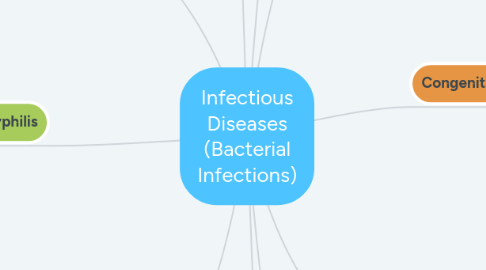
1. Tuberculosis
1.1. Etiology
1.1.1. Mycobacterium tuberculosis
1.2. Description
1.2.1. oral lesions are rare but may be deep or superficial ulcers that are painful and nonhealing. It's a primary infection of the lungs, but bacteria can spread to other areas of the body
1.3. Diagnosis
1.3.1. Laboratory, Microscopic
1.4. Prognosis
1.4.1. Good
1.5. Treatment
1.5.1. Combination of antiTB meds such as isoniazid, refampin, and rifapentine.
2. Actinomycosis
2.1. Etiology
2.1.1. Actinomyces israelii
2.2. Description
2.2.1. Draining abscesses found in the skin and oral mucosa
2.3. Diagnosis
2.3.1. Clinical, Microscopic
2.4. Prognosis
2.4.1. Good
2.5. Treatment
2.5.1. Long-term, high-dose antibiotic therapy
3. Syphilis
3.1. Etiology
3.1.1. Treponema pallidum
3.2. Description
3.2.1. Usually seen in sexually active adults. Primary Lesions: chancre Secondary Lesions: mucous patches Tertiary lesions: gumma
3.3. Diagnosis
3.3.1. Clinical, Laboratory
3.4. Prognosis
3.4.1. Good
3.5. Treatment
3.5.1. Antibiotics, usually penicillin
4. Necrotizing Ulcerative Gingivitis
4.1. Etiology
4.1.1. Borrelia vincentii plus fusiform bacillus
4.2. Description
4.2.1. painful, red gingivitis with cratering of the interdental papillae, foul odor, and metallic taste found in the gingiva of adolescents and adults.
4.3. Diagnosis
4.3.1. Clinical
4.4. Prognosis
4.4.1. Good
4.5. Treatment
4.5.1. Antibiotics, debridement of necrotic tissue, and good oral hygiene care
5. Acute Osteomyelitis
5.1. Etiology
5.1.1. Bacteria extending from a periapical abscess or following the fracture of a bone or surgery, and it may also result from bacterimia
5.2. Description
5.2.1. Acute inflammation of the bone and bone marrow
5.3. Diagnosis
5.3.1. Clinical, Laboratory
5.4. Prognosis
5.4.1. Good
5.5. Treatment
5.5.1. Drainage of the area, antibiotic therapy, and surgical debridement may also be needed
6. Impetigo
6.1. Etiology
6.1.1. Staphylococcus aureus or rarely Streptococcus pyogenes
6.2. Description
6.2.1. Vesicles or crusted lesions most commonly seen on face and extremities of children
6.3. Diagnosis
6.3.1. Clinical, Laboratory
6.4. Prognosis
6.4.1. Good
6.5. Treatment
6.5.1. Topical or systemic antibiotics
7. Tonsillitis and Pharyngitis
7.1. Etiology
7.1.1. Streptococcus pyogenes and other bacteria and viruses
7.2. Description
7.2.1. Enlarged tonsils and mucosal redness on the posterior oral cavity, tonsils, and oropharynx occurring in both children and adults
7.3. Diagnosis
7.3.1. Clinical, Laboratory
7.4. Prognosis
7.4.1. Good if viral, Good if found early in bacterial
7.5. Treatment
7.5.1. Systemic antibiotics if bacterial
8. Congenital Syphilis
8.1. Etiology
8.1.1. Treponema pallidum
8.2. Description
8.2.1. Transmitted from infected mother to fetus, can cause facial and dental abnormalities.
8.3. Diagnosis
8.3.1. Cllinical, Laboratory
8.4. Prognosis
8.4.1. Good
8.5. Treatment
8.5.1. Antibiotics, usually penicillin
9. Pericoronitis
9.1. Etiology
9.1.1. Inflammation caused by usually normal microflora
9.2. Description
9.2.1. Red, painful, swollen tissue around th crown of the partially erupted tooth. More commonly seen in adolescents and young adults at the eruption of 3rd molars
9.3. Diagnosis
9.3.1. Clinical
9.4. Prognosis
9.4.1. Excellent
9.5. Treatment
9.5.1. Debridement and irrigation, antibiotic therapy, and extraction of impacted tooth
10. Chronic Osteomyelitis
10.1. Etiology
10.1.1. Bacterial infection
10.2. Description
10.2.1. Long-standing inflammation of the bone
10.3. Diagnosis
10.3.1. Clinical, Radiographic, Laboratory
10.4. Prognosis
10.4.1. Good
10.5. Treatment
10.5.1. Debridement and antibiotic therapy, sometimes hyperbaric oxygen may also be used

